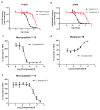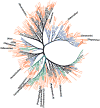A pharmacological organization of G protein-coupled receptors
- PMID: 23291723
- PMCID: PMC3560304
- DOI: 10.1038/nmeth.2324
A pharmacological organization of G protein-coupled receptors
Abstract
Protein classification typically uses structural, sequence or functional similarity. Here we introduce an orthogonal method that organizes proteins by ligand similarity, focusing on the class A G-protein-coupled receptor (GPCR) protein family. Comparing a ligand-based dendrogram to a sequence-based one, we identified GPCRs that were distantly linked by sequence but were neighbors by ligand similarity. Experimental testing of the ligands predicted to link three of these new pairs confirmed the predicted association, with potencies ranging from low nanomolar to low micromolar. We also predicted hundreds of non-GPCRs closely related to GPCRs by ligand similarity and confirmed several cases experimentally. Ligand similarities among these targets may reflect the conservation of identical ligands among unrelated receptors, which signal in different time domains. Our method integrates these apparently disparate receptors into chemically coherent circuits and suggests which of these receptors may be targeted by individual ligands.
Conflict of interest statement
BKS declares a competing financial interest: he is the founder of SeaChange Pharmaceuticals, which uses chemoinformatics for target prediction. All other authors declare no competing interests.
Figures




Comment in
-
A ligand's-eye view of protein similarity.Nat Methods. 2013 Feb;10(2):116-7. doi: 10.1038/nmeth.2339. Nat Methods. 2013. PMID: 23361090 No abstract available.
-
G protein-coupled receptors: finding common threads.Nat Rev Drug Discov. 2013 Mar;12(3):187. doi: 10.1038/nrd3959. Epub 2012 Feb 15. Nat Rev Drug Discov. 2013. PMID: 23411721 No abstract available.
References
Publication types
MeSH terms
Substances
Grants and funding
LinkOut - more resources
Full Text Sources
Other Literature Sources

